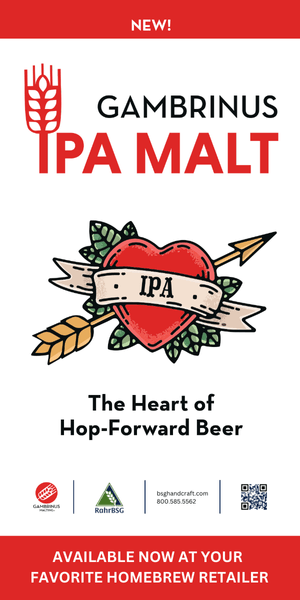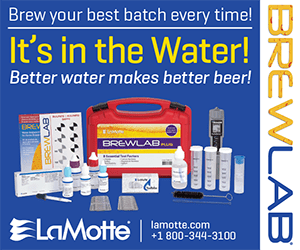Making Malt Coolers
At last, an answer for your friends who say, “But I don’t like beer. Why don’t you make some wine coolers?” Their “wine” coolers are probably malt beverages — tropically flavored beer!
Okay, admit it. You’ve got them. We all do. No matter how long you’ve been brewing or how good your beer is or how many people you’ve converted to the wonders of homebrewed beer, there’s always that odd friend or acquaintance who never developed the taste for our favorite beverage.
Homebrewers, being good people, want to make everyone happy. Then again, there’s a bit of ego involved, too. If your friends don’t like beer, they can’t appreciate what a brewing genius you are, can they?
What’s a brewer to do? Speaking from personal experience, my first step was to brew a sparkling mead. Good idea, but it took forever to mature and, besides, this champagne-like brew is much more at home at a dinner party than on a weekend at the campground. The latter being more my style, I reasoned that my friends needed something more casual. Since my hopeless friends tended to bring a supply of Bartles & Jaymes, I decided to make them something they’d like.
Let’s start with this. You’d be hard pressed to find a true wine cooler on the shelves of your local liquor store. What’s commonly known as a “wine cooler” is almost certainly a malt-based alcohol beverage, just like beer! There hasn’t been any wine in commercial coolers for years. In fact if you look at the case the four-packs of coolers come in, you’ll find that the Treasury Department’s designation for the beverage is “flavored beer.” Whaddaya know! Your friends already like beer! Now you just have to make the kind of beer they like.
Although there are many similarities between making traditional beer and making malt coolers, there are several differences as well. Body, color, and flavorings all have to be adjusted for this beverage. In many cases what you use will depend on your (or your friends’) preferences. In general, though, you’ll want to keep the body fairly thin, the color light, and the malt flavor at a minimum. The color and flavor will change when you eventually add your flavoring agents (such as Kool-Aid). Unlike in beer, you will add no hops. Well, you might want to add half a pellet, just so you can say you’re still making beer.
So, we want thinner body, little malt flavor, and no hops. What’s in this stuff, anyway? To get the lightest color possible, I’ve found that dry malt extract (extra light) tends to work best. Liquid malt extract can also be used, but I’ve found that it tends to darken the wort a little.
Next, forget everything you know about avoiding adjuncts. Sure, some adjuncts tend to make your beer thin and cidery. Go ahead. Add ’em! Thin is in! And any cidery flavors you encounter will be offset by your flavoring agents. I like to add corn syrup. Besides the fact that it’s economical and easy to find, corn syrup ferments easily at ale temperatures and will add the residual sweetness those cooler-loving friends crave. Since we do need a little body, you’ll also want to add some malto-dextrin.
Yeast. Can’t brew without it.
The thing to remember here is that you’re making a malt cooler. It has nothing to do with wine! Don’t — repeat, don’t — use a wine or champagne yeast. If you do, you’ll end up with a highly alcoholic, sour concoction that will make your non-beer drinking friends decide they don’t like coolers much anymore, either. Use a good-quality ale yeast. Australian or American works just fine. You can use a liquid yeast if you like, but the fermentation on this brew is off, running, and done so fast that I don’t see any advantage. Use a dry yeast instead, and save your money for your next big beer!
Brewing is done just like any extract beer you’ve ever made. Be sure to boil your ingredients. Since you’re not using hops, you don’t need to worry about extracting flavor, bitterness, or aroma. The boil is done for clarity and sterilization purposes. Flavoring agents are added after fermentation. One other note of caution: Watch your brew kettle. A corn-syrup wort will boil over so fast it’ll make your carboy spin. Continue with fermentation as usual.
When fermentation is complete, you’ve got an alcoholic, bland, rather tasteless liquid. Now it’s time for some flavor. Don’t laugh, but I’ve found that Kool-Aid makes a fine flavoring agent. It’s readily available, inexpensive, and comes in an amazing variety of natural and otherworldly flavors. My taste-testers liked a flavor called “Mango-Berry Punch.” It’s bright red and looks like a cooler. My personal favorite was a basic lemonade, but that’s just the kind of guy I am, I guess.
You can’t really put this brew into Bartles & Jaymes’ bottles, impressive as it may be to your crew. The bottles won’t withstand the carbonation pressure, and the screw caps won’t give you a good seal. If you put it into beer bottles, all your friends will tell you it “tastes like beer.” You can keg it, if that’s what you’re into. My approach, since I don’t use kegs, was to use green two-liter bottles from citrus sodas. The product looks the same as some bottled commercial coolers, and it will keep, with an adequate seal, for four months or a little longer.
Feel free to experiment with these directions. I started this project with an idea, a wing, and a prayer to the brewing gods. I had some good luck and was able to produce some pretty good beverages, even if they didn’t fit my definition of beer. You might want to experiment with some other adjuncts or flavoring agents. I’m eager to try a cooler with rice syrup, but I think my very next project will be to use Berry Blue Kool-Aid for flavor. Imagine, a blue (beer) cooler! Experiment, have fun, and let your friends who don’t like beer see how talented you are!
Don’t Whine Cooler
(5 gallons, extract)
Ingredients:
• 4 lbs. Muntons extra-light dry malt extract
• 48 oz. light corn syrup
• 1 lb. malto-dextrin
• 1 pkg. American or Australian ale yeast
• 10 pkgs. unsweetened Kool-Aid or other powdered drink mix (your choice of flavors)
• 3/4 cup corn sugar for priming
Step by Step:
Boil 1 gal. water in brew kettle. Add dry malt extract and malto-dextrin, stirring until dissolved. Add corn syrup and return to boil. Boil for 30 min. Add to fermentation vessel that has 4 gal. pre-boiled, chilled water. Pitch yeast and install airlock.
Fermentation should be complete at 65° to 70° F in five to seven days. Following fermentation, mix corn sugar dissolved in one pint boiled water, fermented liquid, and packaged drink mix in bottling bucket. Be careful; the liquid will foam with the addition of the acidic drink mix. Bottle into eight sterilized 2-liter green soda bottles. Tighten on sterilized caps. Cooler is ready to drink when clear (seven to 10 days) but will improve over the next few weeks. Consume within four months if bottled in this fashion.





